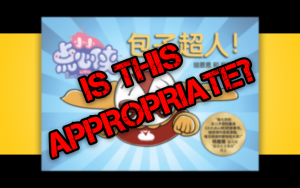When learning a Second or Foreign Language, should I only choose books at the “Appropriate Reading Level”?
In 1st grade, my daughter, Yakuza Baby (the nickname we gave her because she was born while Colin and I were watching a Japanese gangster movie), had fallen in love with reading and was fast becoming a “bookworm”. And then she got into graphic novels and brought one to school for her reading time.
They had reading time in 1st grade and every day, the kids had to write short reports on what they read. They were told they could pick their own books. Her teacher, Mr. P told me that she was not allowed to bring the graphic novel to school for reading time or write a report on it. I asked him why. Mr. P said that he it’s because he didn’t know the reading level for the graphic novel and wouldn’t be able to effectively evaluate Yakuza Baby’s reading level if he allowed her to read it and write a report on it.
Yakuza Baby told me that the books in their classroom were all classified into baskets marked with different “levels”, but most of them were really boring because they were written specifically to fall within their “levels”.
Yakuza Baby and I were both dumbfounded because in this situation, it seemed like “the appropriate reading level” was more important than “the appropriate interest level”.
Picking books at the “appropriate reading level” seems to make some kind of logical sense, because we want to push kids but don’t want them to get frustrated.
BUT if leveled readers are the ONLY source of reading, it will put kids off reading because it prevents them from being surprised by language, learning funny vocabulary, and finding words that actually express what they are thinking, and not simply what their linguistic level is at.
And then I started creating books for kids
When Colin and I started creating books for kids, we worked on this principle that “the appropriate interest level” is much more important than “the appropriate reading level”. With the Little Dim Sum Warriors series, we started with the everyday experiences of kids, telling each other stories of what we had observed in the playground and what we were observing about our daughter. We wanted the stories to be relevant to children’s lives… albeit in cute dumpling form.
So for example, watching kids in the playground struggle anxiously to learn how to ride a bike while various well-meaning older kids and adults yelled instructions at them (often causing even more stress) became the backbone of our book “My Way Is The Best 我的方法最好!” –a story that examines the learning process for many things.
Meanwhile, watching our daughter get incredibly frustrated with her own artwork, and then try repeatedly to begin from scratch instead of just fixing the wrong part, evolved into the story, “I Don’t Want Any Mistakes 我不希望出任何差错!” – where Xiajiao is trying to stop mistakes from happening, even though they happen anyway.
Our writing process goes like this: Once we finish a draft with the relevant story beats, we go through it again to see if we can say it even more simply, using simpler words that can convey the same meaning. We would then work with our Chinese translator, Prof. Wenchi Lin, to figure out if we can make the language even funnier and more interesting.
We would NEVER start by designing a story around a prescribed set of words at an “appropriate reading level”, because that would be too restrictive.
There are already so many leveled readers in schools, and other companies have produced thousands of leveled books for Chinese and English learning. They are “educational” books that that have clear “levels”. Most of these are not books that, if they are left on the shelf, kids would be intrigued enough to pick up on their own to read. They are books that are read only if they are assigned as homework.
Our interest is in books that are not simply vocabulary or grammar delivery vehicles but are intriguing enough for kids to want to pick up on their own.
Just like how children need various vitamins to grow, our Dim Sum Warriors stories provide a VARIETY of nutrients to our children’s reading diets—such as INTEREST and INSPIRATION.
We always begin with examining kids’ lives, and know that when our stories are funny and relevant, and we incorporate the appropriate scaffolding (such as home language, pictures and sound), they will naturally attain the “appropriate interest level” so that kids will feel resonance and want to learn more—regardless of unfamiliar vocabulary. It’s why so many kids devoured the Harry Potter series, despite ‘Horcrux’ and ‘Dementor’ not being on any prescribed vocabulary list.
These are great articles about the myth of reading levels:
“Three Myths About Reading Levels” from Psychology Today
“If We Want Bookworms, We Need to Get Beyond Levelled Reading” from Edutopia
And really, what kids need are books that get them to continue reading MORE books.
If you have any questions or topics that you would like me to cover in the areas of education and parenting, please send me an email at yenyen@dimsumwarriors.com. I check all my emails personally and look forward to your questions. However, if you’re a student who’s trying to ask me to do your homework or project for you, I will most likely not have time to respond because I get way too many of those emails and it’s quite impossible to answer them all.

